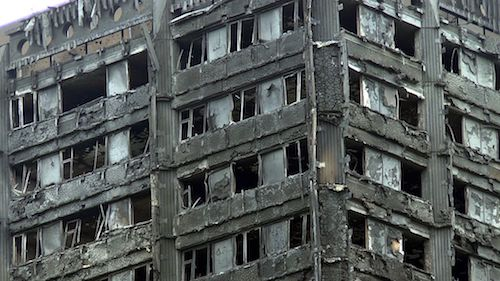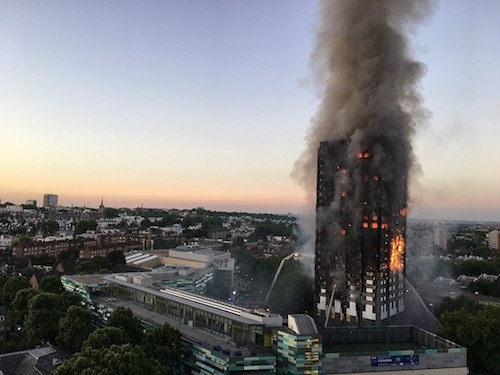Grenfell Official Moves Immunity Request to AG
TUESDAY, FEBRUARY 11, 2020
Late last week, the chair of the Grenfell Tower inquiry, Sir Martin Moore-Bick, announced that he agreed to an application by multiple witnesses for immunity from prosecution relating to any evidence about the incident.
The attorney general will now have to decide whether or not to grant the request.
Disaster Background
On June 14, 2017, Grenfell Tower—a 24-story, 120-home apartment building—caught fire and resulted in the death of 72 people. While the fire started in a fridge-freezer in an apartment on the fourth floor, the blaze then spread to a nearby window. The building had recently undergone a $12.73 million renovation designed by Studio E Architects that was completed in the spring of 2016 and is largely believed to be responsible for why the fire spread so quickly.
At that time, the building was refurbished with a system of polyester powder-coated aluminum rain-screen panels, insulated exterior cladding and double-glazed windows, as well as a communal heating system.
A Guardian investigation in 2018 revealed that nonflammable aluminum panels had initially been proposed for the refurb but were switched out to save money.

 |
| ChiralJon, CC-SA-BY 2.0, via Wikimedia Commons |
|
Late last week, the chair of the Grenfell Tower inquiry, Sir Martin Moore-Bick, announced that he has agreed to an application by multiple witnesses for immunity from prosecution relating to any evidence about the incident. |
The publication found that, at first, under the local government’s preferred contractor, Leadbitter, subcontractor D+B Facades had provided a 3.3 million-pound (roughly $4.1 million) quote to fit a system of aluminum panels backed with mineral wool insulation.
A few months later, the council decided that Leadbitter wanted to spend too much on the refurbishment, and put the contract out to tender to save about 1.3 million pounds. It went with a different contractor, Rydon, which provided a lower bid, but fitted the tower with the combustible cladding that authorities believe contributed to the number of fatalities in the fire.
The Guardian found that the council had originally wanted to spend 6 million pounds on Grenfell, but later set a different budget of 9.7 million pounds, because it realized it needed to replace the heating system. Leadbitter was on course to spend 11.3 million pounds, which is why council says it put the contract back out.
Manufacturer Omnis Exteriors confirmed that they supplied the Arconic Architectural Product to Harley Facades—the subcontractor that Rydon utilized for the cladding work.
Around the same time in 2018, BBC News uncovered that the Reynobond PE cladding was subjected to European tests in 2014 and 2015 for “reaction to fire,” in which products are typically given an A to F rating, with A being the highest.
(Many officials believed that the legal standard for such towers was a B rating. While that belief had been contested among industry professionals, the legal minimum rating now, post-Grenfell fire, has been upgraded to A.)
The reports from the 2014-15 tests reveal that two types of the Reynobond, both of which were installed at Grenfell, had less than B ratings. One type, called “riveted,” received a C classification, while another, “cassette,” received an E classification.
The BBC obtained correspondence from Arconic to clients confirming the ratings.
The Inquiry
Phase One of the inquiry was completed last fall, with the findings published on Oct. 30. This phase was to look at what happened on the night of the fire itself, and the 1,000-page report criticized not only the response to the fire but the 2016 renovation as well.
Arguably of most importance, Moore-Bick, a retired Court of Appeals judge, said that it seems that the refurbishment did not comply with the building regulations requirement to adequately resist the spread of fire.
“There is compelling evidence that Requirement B4(1) was not met in this case,” he said. “It would be an affront to common sense to hold otherwise.”
 |
| Natalie Oxford, CC-SA-BY 4.0, via Wikimedia Commons |
|
Phase One of the inquiry was completed last fall, with the findings published on Oct. 30. This phase was to look at what happened on the night of the fire itself, and the 1,000-page report criticized not only the response to the fire but the 2016 renovation as well. |
In addition to the preliminary conclusions on the 2016 refurbishment, the report also accuses the fire brigade’s response to the fire as having “systematic failures” with no contingency plan to evacuate the tower. It also criticized the brigade’s decision to maintain the “stay-put policy” even when the stairs were passable.
After the report, Dany Cotton, the London Fire Commissioner who was in charge of the response, resigned.
The second phase, which started Jan. 27, is to examine the refurbishment, including the installation of flammable cladding.
According to the Telegraph, this phase is said to be more complex than the first, which took 16 months to complete. Preparation for this phase has reportedly unearthed 200,000 documents and the phase will be split into eight “modules” with 21 companies and 600 individuals named as “core participants.”
Among the modules, the areas that will be investigated include the refurbishment itself, the testing of the cladding, complaints from residents prior to the fire, the management of the building and the aftermath of it all.
Some estimates say that it could take Moore-Bick until at least 2023 to publish a final report. Only then would police and prosecutors get a chance to review the findings and then pursue charges, if any.
A few days into the second phase, after much finger-pointing, lawyers for Studio E, Rydon, the TMO and Harley wrote to Moore-Bick arguing that their clients could claim privilege against self-incrimination and not answer questions, noting that they would only speak openly if the attorney general gave an understanding that nothing they said would be used against them in criminal prosecution.
“The scope of self-incrimination is broad and extends not only to refusing to answer questions or give information that may directly incriminate the witness but also to answer or provide information which ‘might lead to a line of inquiry which would or might form a significant step in the chain of evidence required for a prosecution,’” the lawyers said.
What Now
At that point, Moore-Bick paused the inquiry, which is now slated to resume Feb. 24 at the earliest, according to reports.
In his letter to the attorney general, Moore-Bick wrote: “[We] have come to the conclusion that it will not be possible for the inquiry properly to fulfil its terms of reference if witnesses do not have an assurance that the answers they give to questions will not be used in furtherance of criminal proceedings against them.
“Without an undertaking of the kind described above, it is very likely that witnesses who were involved in the procurement and design of the refurbishment, the choice of materials and the execution of the work will claim privilege against self-incrimination, or, if they do not, that they will be considerably less candid than would otherwise have been the case as a result of trying to avoid saying anything that might harm their position in the future.”
He noted, though, that contrary to previous reports, immunity in this sense would not grant anyone complete immunity from prosecution. For instance, such an order would not apply to any statements or documents already in possession of the inquiry, not does it prevent prosecuting authorities from using answers given by one witness to further an investigation of another.
Tagged categories: Building Envelope; Cladding; Condominiums/High-Rise Residential; Fire; Government; Health and safety; Safety









